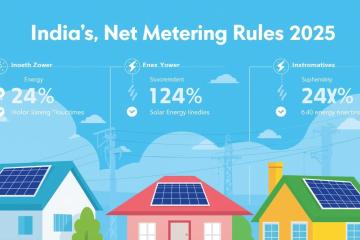
Dive into the Economics of Solar Energy and discover its cost-effectiveness, benefits, and impact on the energy market. Solar energy has become more than just an eco-friendly alternative; it’s now a viable financial investment for homeowners, businesses, and investors. Understanding the economics of solar power goes beyond the environmental benefits—it delves into the financial aspects, such as return on investment (ROI), payback periods, incentives, and long-term savings.
Introduction:
As the world grapples with the urgent need for sustainable energy solutions, India stands at the forefront of the renewable energy revolution, particularly in solar power. In this blog, we’ll delve into the fascinating realm of the economics of solar energy in India, exploring its potential, challenges, and the transformative impact it holds for the nation’s energy landscape.
Understanding the Economics of Solar Energy in India:
Harnessing India’s Solar Potential:
The vast expanse of India is bathed in sunlight for a significant portion of the year, offering an immense opportunity to tap into solar energy resources. With over 300 sunny days annually, the country’s solar potential is staggering. Regions such as Rajasthan, Gujarat, and Maharashtra boast particularly high levels of solar irradiance, making them prime locations for solar power generation.
Cost Competitiveness and Affordability:
One of the most compelling aspects of solar energy in India is its increasing cost competitiveness. Over the years, the cost of solar panels and associated equipment has plummeted, thanks to technological advancements and economies of scale. As a result, solar energy tariffs in India have become highly competitive, often rivaling or even undercutting traditional energy sources such as coal.
Government Support and Policy Framework:
The Indian government has played a pivotal role in driving the adoption of solar energy through various policies and incentives. Initiatives like the Jawaharlal Nehru National Solar Mission (JNNSM) aim to ramp up solar power capacity and facilitate its integration into the national grid. Additionally, subsidies, tax incentives, and renewable purchase obligations (RPOs) incentivize investments in solar energy projects, both large and small.
Challenges and Hurdles to Overcome:
Grid Integration and Storage Solutions:
Despite its abundant potential, solar energy’s intermittent nature poses challenges for grid stability and reliability. Effective integration into the existing grid infrastructure, coupled with robust energy storage solutions, is crucial to ensure a steady and uninterrupted power supply.
Land Acquisition and Regulatory Bottlenecks:
Large-scale solar projects often require significant land area, leading to challenges in acquisition, permitting, and environmental clearances. Streamlining regulatory processes and addressing land use conflicts are essential to expedite project development while minimizing ecological impact.
Financing and Investment Barriers:
Access to affordable financing remains a key barrier to widespread solar energy adoption, particularly for smaller players and decentralized installations. Long-term financing options, risk mitigation mechanisms, and innovative financial instruments are needed to attract investment and spur growth in the sector.
Conclusion
The economics of solar energy in India present a promising outlook, driven by technological innovation, supportive policies, and growing environmental consciousness. Overcoming challenges and seizing opportunities in this dynamic landscape will be crucial in realizing India’s vision of a sustainable and energy-secure future powered by the sun.
Frequently Asked Questions (FAQs):
Q1. Is solar energy economically viable in India?
A1. Yes, solar energy is increasingly economically viable in India, thanks to declining costs, supportive government policies, and abundant solar resources.
Q2. What are the main incentives for investing in solar energy projects in India?
A2. The Indian government offers various incentives such as subsidies, tax benefits, accelerated depreciation, and renewable purchase obligations (RPOs) to promote solar energy adoption.
Q3. How does solar energy contribute to India’s energy security and sustainability goals?
A3. Solar energy reduces India’s reliance on fossil fuels, enhances energy security, mitigates greenhouse gas emissions, and contributes to achieving sustainability goals and combating climate change.
Q4. What are the challenges associated with solar energy grid integration?
A4. Challenges include intermittency, grid stability issues, the need for energy storage solutions, and regulatory barriers that need to be addressed for effective grid integration.
Q5. How can individuals and businesses contribute to the growth of solar energy in India?
A5. Individuals and businesses can contribute by installing rooftop solar panels, investing in solar projects, advocating for supportive policies, and promoting energy efficiency measures in their operations.



0 Comments